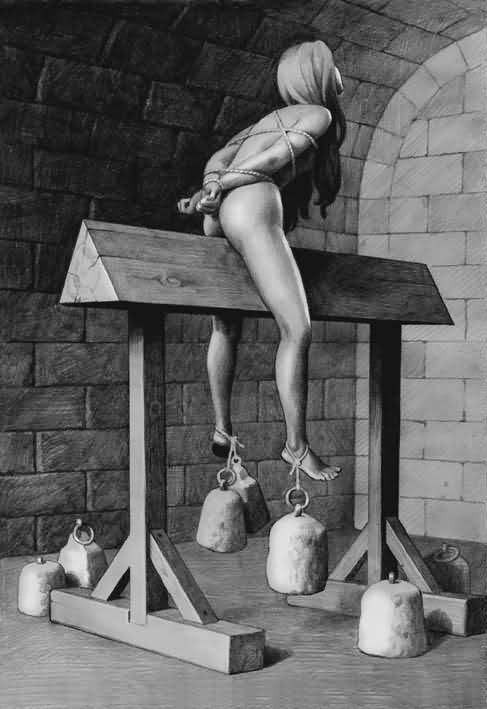Extracts from THE HAMMER OF WITCHES [Malleus maleficarum], 1486

Even with the papal bull the German inquisitors found their preparation incomplete. Soon after their return from Rome they set about compiling a handbook – an exposition of witchcraft and a code of procedure for detection and punishment of witches. Completed in 1486, it was called the Hammer of Witches.
The method of beginning an examination by torture is as follows: First, the jailers prepare the implements of torture, then they strip the prisoner (if it be a woman, she has already been stripped by other women, upright and of good report). This stripping is lest some means of witchcraft may have been sewed into the clothing-such as often, taught by the Devil, they prepare from the bodies of unbaptized infants, [murdered] that they may forfeit salvation. And when the implements of torture have been prepared, the judge, both in person and through other good men zealous in the faith, tries to persuade the prisoner to confess the truth freely; but, if he will not confess, he bid attendants make the prisoner fast to the strappado or some other implement of torture. The attendants obey forthwith, yet with feigned agitation. Then, at the prayer of some of those present, the prisoner is loosed again and is taken aside and once more persuaded to confess, being led to believe that he will in that case not be put to death.
Here it may be asked whether the judge, in the case of a prisoner much defamed, convicted both by witnesses and by proofs, nothing being lacking but his own confession, can properly lead him to hope that his life will be spared when, even if he confess his crime, he will be punished with death.
It must be answered that opinions vary. Some hold that even a witch of ill repute, against whom the evidence justifies violent suspicion, and who, as a ringleader of the witches, is accounted very dangerous, may be assured her life, and condemned instead to perpetual imprisonment on bread and water, in case she “I give sure and convincing testimony against other witches; yet this penalty of perpetual imprisonment must not be announced to her, but only that her life will be spared, and that she will be punished in some other fashion, perhaps by exile. And doubtless such notorious witches, especially those who prepare witch-potions or who by magical methods cure those bewitched, would be peculiarly suited to be thus preserved, in order to aid the bewitched or to accuse other witches, were it not that their accusations cannot be trusted, since the Devil is a liar, unless confirmed by proofs and witnesses.
Others hold, as to this point, that for a time the promise made to the witch sentenced to imprisonment is to be kept, but that after a time she should be burned.
A third view is, that the judge may safely promise witches to spare their lives, if only he will later excuse himself from pronouncing the sentence and will let another do this in his place….
But if, neither by threats nor by promises such as these, the witch can be induced to speak the truth, then thejailers must carry out the sentence, and torture the prisoner according to the accepted methods, with more or less of severity as the delinquent’s crime may demand. And, while he is being tortured, he must be questioned on the articles of accusation, and this frequently and persistently, beginning with the lighter charges-for he will more readily confess the lighter than the heavier. And, while this is being done, the notary must write down everything in his record of the trial – how the prisoner is tortured, on what points he is questioned and how he answers.
And note that, if he confesses under the torture, he must afterward be conducted to another place, that he may confirm it and certify that it was not due alone to the force of the torture.
But, if the prisoner will not confess the truth satisfactorily, other sorts of tortures must be placed before him, with the statement that unless he will confess the truth, he must endure these also. But, if not even thus he can be brought into terror and to the truth, then the next day or the next but one is to be set for a continuation of the tortures – not a repetition, for it must not be repeated unless new evidences produced.
The judge must then address to the prisoners the following sentence: We, the judge, etc., do assign to you, such and such a day for the continuation of the tortures, that from your own mouth the truth may be heard, and that the whole may be recorded by the notary.
And during the interval, before the day assigned, the judge, in person or through approved men, must in the manner above described try to persuade the prisoner to confess, promising her (if there is aught to be gained by this promise) that her life shall be spared.
The judge shall see to it, moreover, that throughout this interval guards are constantly with the prisoner, so that she may not be I alone; because she will be visited by the De and tempted into suicide








